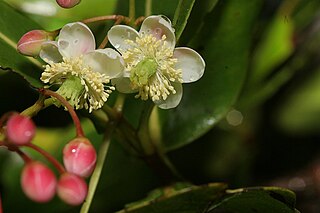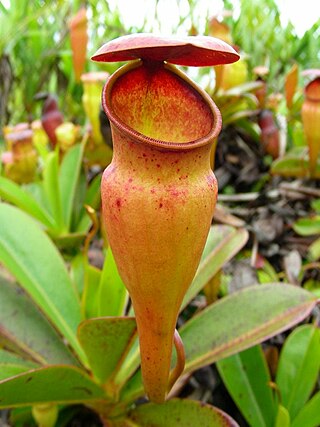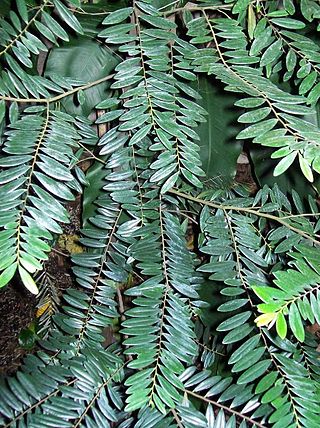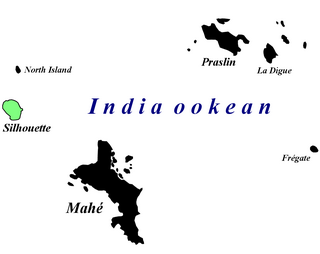
Lodoicea, commonly known as the sea coconut, coco de mer, or double coconut, is a monotypic genus in the palm family. The sole species, Lodoicea maldivica, is endemic to the islands of Praslin and Curieuse in the Seychelles. It has the largest seed in the plant kingdom. It was also formerly found on the small islets of St Pierre, Chauve-Souris, and Ile Ronde, all located near Praslin, but had become extinct there for a time until recently reintroduced.

The Seychelles parakeet or Seychelles Island parrot is an extinct species of parrot that was endemic to the Seychelles in the Indian Ocean. It was scientifically named Palaeornis wardi by the British ornithologist Edward Newton in 1867, and the specific name honours the British civil commissioner Swinburne Ward who procured the specimens that formed the basis for the description. It was found on the islands of Mahé, Silhouette, and possibly Praslin. Ten skin specimens exist today, but no skeletons. Though the species was later moved to the genus Psittacula, genetic studies have led some researchers to suggest it should belong in a reinstated Palaeornis along with the closely related Alexandrine parakeet (P. eupatria) of Asia.

Medusagyne oppositifolia, the jellyfish tree, is a species of tree endemic to the island of Mahé, of the Seychelles. It is the only member of the genus Medusagyne of the tropical tree and shrub family Ochnaceae. The plant, thought to be extinct until a few individuals were found in the 1970s, gets its common name from the distinctive jellyfish-like shape of its dehisced fruit.

Nepenthes pervillei is the only pitcher plant found in the Seychelles, where it is endemic to the islands of Mahé and Silhouette. It grows in rocky areas near granitic mountain summits, its roots reaching deep into rock fissures. The species has an altitudinal range of 350–750 m above sea level. Like all members of the genus, N. pervillei is dioecious, having separate male and female plants.
Kaliphora madagascarensis is a species of evergreen shrub or small tree. It is endemic to Madagascar, where it inhabits subhumid woodlands and forests in eastern Madagascar, in the provinces of Antananarivo, Antsiranana, Fianarantsoa, and Mahajanga.

Phoenicophorium, the thief palm, is a monotypic genus of flowering plant in the family Arecaceae. The sole species is Phoenicophorium borsigianum.

Thomasset's Seychelles frog or Thomasset's frog is a species of frog in the family Sooglossidae. It is endemic to Seychelles. There are two known populations: one on Silhouette Island and one on Mahé Island.
Glionnetia is a monotypic genus of flowering plants in the family Rubiaceae. The genus contains only one species, viz. Glionnetia sericea, which is endemic to Mahé and Silhouette Island in the Seychelles. The species thrives mainly on high ridges in the mountains and it does not seem to grow well at lower altitudes. Glionnetia sericea is a small flower with paniculate terminal inflorescences and it has capsules that are dispersed by wind.
Melanophylla alnifolia is a species of plant in the Torricelliaceae family. It is endemic to eastern Madagascar. Its natural habitat is tropical moist lowland and montane forests. It is threatened by habitat loss.
Myrsine seychellarum, also known as Bwa Klate, is a species of plant in the family Primulaceae. It is endemic to Seychelles.
Trilepisium gymnandrum is a species of Trilepisium that is endemic to the Seychelles, where it is threatened by habitat loss. Its natural habitat is subtropical or tropical moist lowland forests. Five mature individuals are known in two sub-populations in the mid to high altitude forests of Silhouette Island. The 18th century populations of the larger Mahé and Praslin islands have presumably been extirpated.

The Granitic Seychelles are the islands in Seychelles which lie in central position on the Seychelles Bank and are composed of granite rock. They make up the majority of the Inner Islands, which in addition include the coral islands along of the rim of the Seychelles Bank, namely Bird Island and Denis Island. The Granitic Seychelles contrast with the Coralline Seychelles or the Outer Islands, several island groups made up of low coral islands with dry, infertile soils.

Protarum is a monotypic genus of flowering plants in the family (Araceae). The single species composing the genus is Protarum sechellarum. It is endemic to the Seychelles. This species was previously placed in the subfamily Colocasioideae in the tribe Protareae, but it has since been reclassified to the subfamily Aroideae in the tribe Colocasieae.

Diospyros seychellarum, locally known as bwa sagay, is a rare endemic plant from the Seychelles. It occurs on the islands of Mahé, Praslin, Silhouette and Felicite. It is locally known as bwa sagay.

The tiger chameleon, also known as the Seychelles tiger chameleon, is the only species in the resurrected genus Archaius. Initially placed into Chamaeleo, it was for some time moved to the genus Calumma by some. It is an endangered species of chameleon, found only on the Seychelles islands of Mahé, Silhouette and Praslin.
Chapelieria is a monotypic genus of flowering plants in the family Rubiaceae. The genus contains only one species, viz. Chapelieria madagascariensis, which is endemic to Madagascar.

Rubioideae is a subfamily of flowering plants in the family Rubiaceae and contains about 7600 species in 27 tribes.
Xyroschoenus hornei is a species of flowering plant belonging to the family Cyperaceae. It is a perennial sedge endemic to the Seychelles. It is the sole species in genus Xyroschoenus. It is native to the islands of Mahé, Silhouette, Praslin, and Curieuse, where it grows in the forest understory.

Afrolychas braueri, commonly known as the Seychelles forest scorpion, is a species of scorpion in the family Buthidae. It is currently thought to survive only on Silhouette Island, Seychelles, although the species was historically found on two additional Seychellois islands. This scorpion lives in leaf litter in forests that are largely unaffected by invasive plant species. It is a small yellowish-brown scorpion with three prominent keels on the dorsal surface of its mesosoma, which distinguishes it from other scorpions. While not much is known about the Seychelles forest scorpion's ecology due to the paucity of sightings, it is known to rely solely on its venom to capture its prey and defend its young. Its venom is not dangerous to humans.
Magnolia sororum is a species of flowering plant in the family Magnoliaceae. It is commonly known as vaco. It is native to the mountain forests of Costa Rica and western Panama, and may range into Nicaragua.












